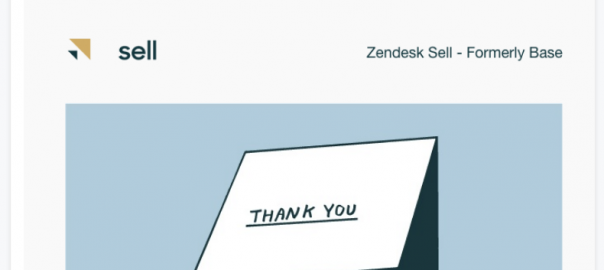— June 25, 2019
An email subject line packs a powerful punch (or at least it should). With the amount of emails the average worker receives a day (121 daily emails on average!), you need to grab the readers of your sales emails quickly. Instead of viewing the limited characters of a subject line as a challenge, view it as an opportunity.
Here are sales email subject lines lessons from twelve companies to help you do just that.
Make the message personal
Accenture found that “75% of customers are more likely to spend their hard-earned money with brands that recognize them by name and remember information about them.” Use this desire to your advantage with sales email subject lines.
Include the contact’s name
According to The Washington Post, a “person’s name is the greatest connection to their own identity and individuality.” Using a contact’s name in an email subject line has the same effect as it would in a personal conversation — it establishes a personal connection between the contact and company.
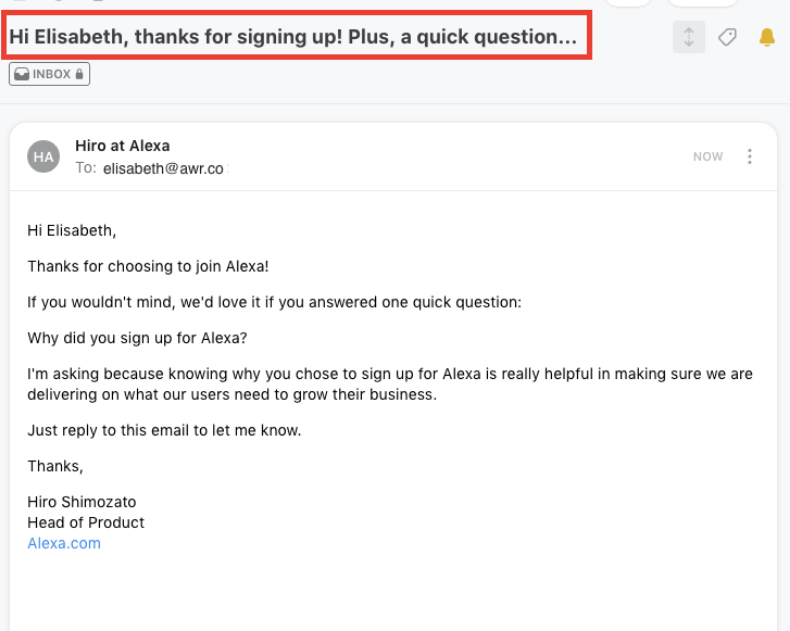
Alexa’s email subject line
Another personalization tactic is to use the contact’s first and last names. Mailchimp found that, although including both first and last names in a subject is less common, it has the largest positive impact on open rates.
Use the word “you”
Too often, our inboxes are slammed full of formal email subject lines, which ultimately sound salesy. Cut through the formal clutter and sound friendly instead. One tactic is to address the recipient using the second person — “you.”
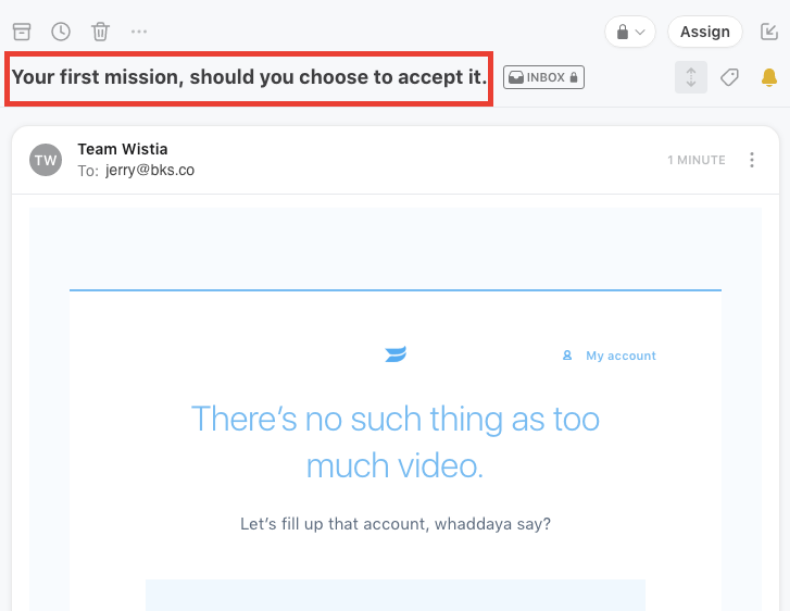
Wistia‘s email subject line
Subject lines like “Are you ready?” “Have you tried XYZ?” are simple, but effective. This tactic makes you sound less formal and more conversational.
Customize your subject line
A report by Silverpop found that 50% of recipients unsubscribe to email lists because the content they receive is not relevant to them and they don’t have any interest in learning about it. Along with using the prospect’s name, take advantage of email segmentation through segmented lists and CRM third-party integrations (e.g., Mailchimp) to create customized email subject lines that individually speak to every prospect’s needs.
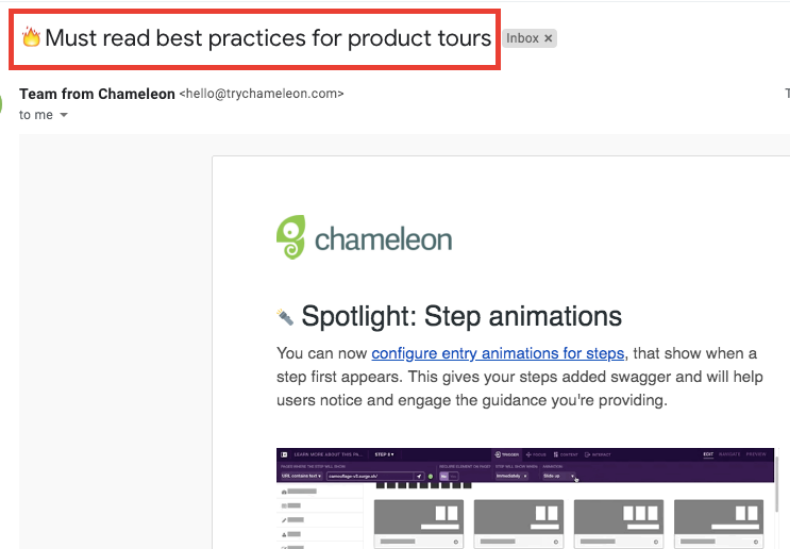
Chameleon’s email subject line
Start by organizing your email list by customer demographics, pain points, etc. Then, divide the customers in each segment according to their purchase stage. For example, if a small financial company is in the pre-purchase stage, create a subject line about “X best blog posts for finance startups.”
Use few words
Wordiness has been the death of many a subject line — people have short attention spans, and long subject lines beg to be skimmed over. Shorter, concise subject lines are not only easier to read, but they also have a higher open rate because they grab the reader’s attention in the inbox.
Write 41-character subject lines
Short subject lines are also easier to read on a mobile device. According to Convince & Convert, 35% of business professionals check email on smartphones and tablets. The number of characters shown depends on the device, but most people view emails on iPhones and Gmail, which show between 41 to 70 characters.
According to Marketo, 41 characters (or 7 words) is the best length for an email subject line, but you can also use fewer. With the average subject line being about 51 characters, your shorter subject lines will have a better chance of standing out.
Compare these two subject lines:
- Get ready for our amazing product upgrade this summer to XYZ 4.0: Sign up today!
- Are you ready for XYZ 4.0?
Which subject line are your eyes more drawn to? Most likely the second one, because you can see the whole message right off the bat.
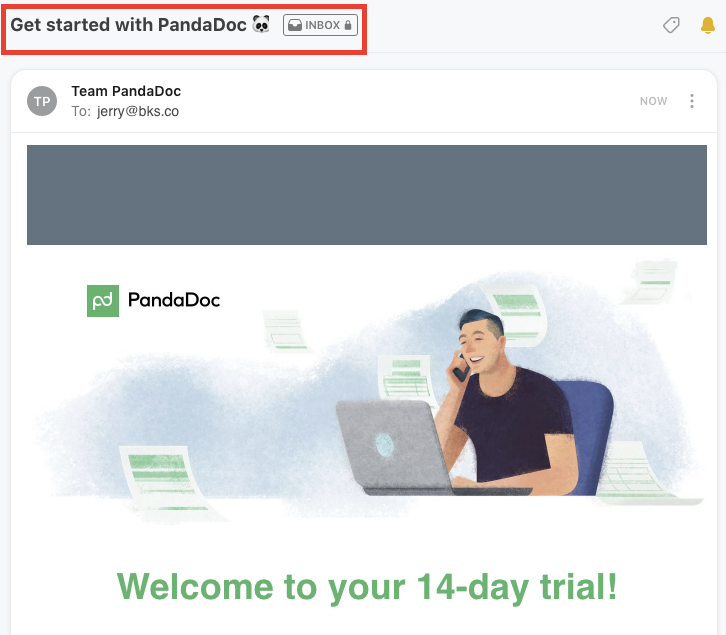
PandaDoc‘s email subject line
Another tip? Think about using sentence-case rather than title-case. “Congrats on your Series B funding!” is much easier to read (and less spammy looking) than “Congrats On Your Series B Funding!”
Pique the reader’s curiosity
By nature, humans are curious. Convey that you have something the reader doesn’t and give them a reason to want to open your email. A few ways to capture your reader’s attention is to ask a question, share number-based facts, and speak to a reader’s pain point.
Ask a question
You don’t have to give away everything about the email in the subject line. Instead, ask a question that hints at the nature of the content. A question makes the reader want to know the answer and fill their knowledge gap. Questions also sound like an actual human conversation and not computer-generated messages.
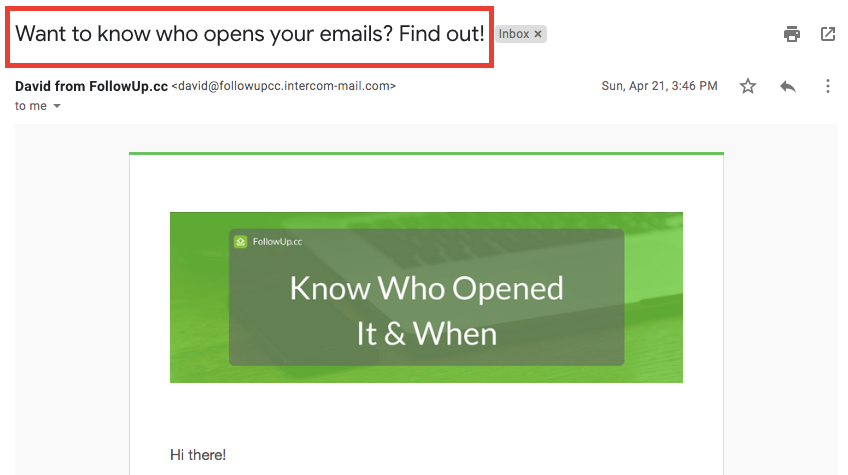
FollowUp‘s email subject line
Simple questions such as “Want to build a startup faster?” are thought-provoking and intriguing without giving away too much.
Share data-based insights
Yesware found that subject lines with hard numbers have higher open and reply rates. Build the prospect’s trust in your company by backing up your claims with data. Talk with marketing about using your company’s original data to develop data-based content.
For example, if your company offers e-Signatures, find out how many of your clients use it to sign documents instead of signing paper documents that must be printed and mailed or scanned and emailed. A possible subject line could be “Decrease time to sign by XX%.”
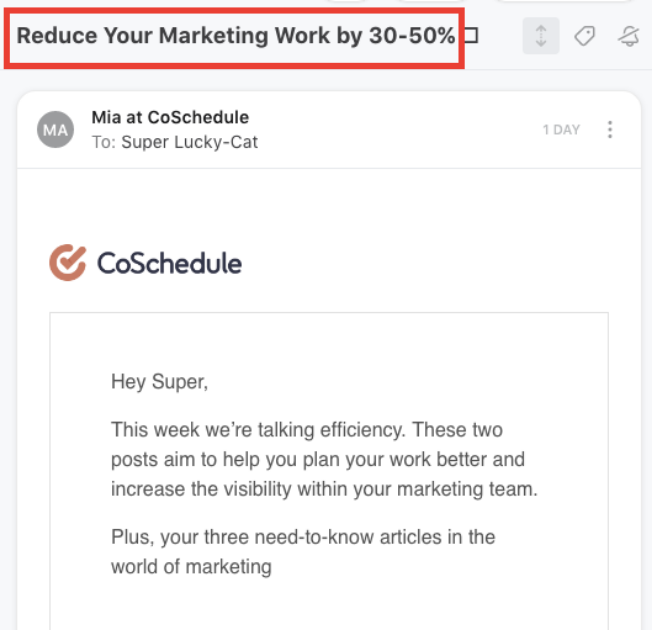
CoSchedule’s email subject line
If you don’t have a bunch of original data to work with, be creative with numbers. For example, “The 3 step guide to social selling,” or “6 ways to improve content marketing” can also be effective.
Convey a pain point
Prospects don’t care about your company’s accomplishments as much as they want to know what you can do for them. How can your product/service solve their problem? Prove in the subject line that you’ve done your research on the prospect and recognize what their business struggles with.
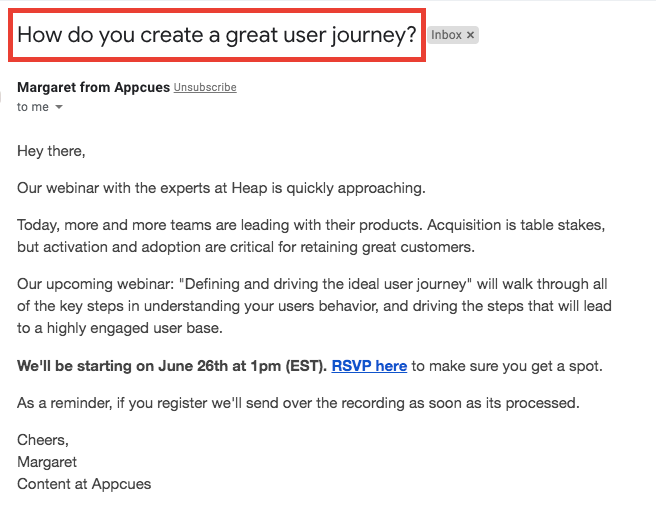
Appcues’ email subject line
Other possible subject lines include “X blogs for [Pain Point]” or “How to improve [Pain Point].” This type of subject line makes you seem more customer-centric than product-centric, which helps set the right tone for a future customer relationship.
Share valuable information
If the reader feels like there’s a gap in their knowledge base, they’re more likely to click your email. First, use tools like a CRM to understand your audience. What questions are current customers asking customer support? What are their main pain points? Then, use this information to craft helpful emails/subject lines.
Be direct
You don’t have to be crazy creative with subject lines. If you’re offering something of value, let the content speak for itself. Share the exact benefit the reader will gain from opening your email in the subject line.
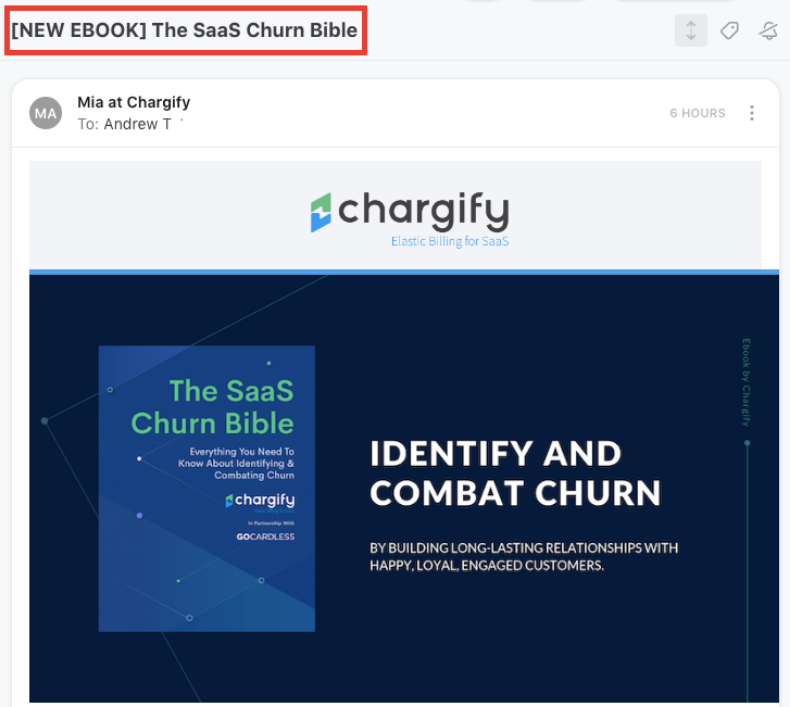
Chargify’s email subject line
“Introducing the 2019 Social Selling Report” or “[Your Company] Video Content Marketing Guide” are subject lines that get straight to the point and convey exactly what the reader will receive.
Continue the value
Have you ever bought something online that promised to be amazing, but when you received the item in the mail, it didn’t even match the description? Disappointing to say the least. An email works the exact same way. Make sure that the body of your email delivers what the subject line promised to the reader.
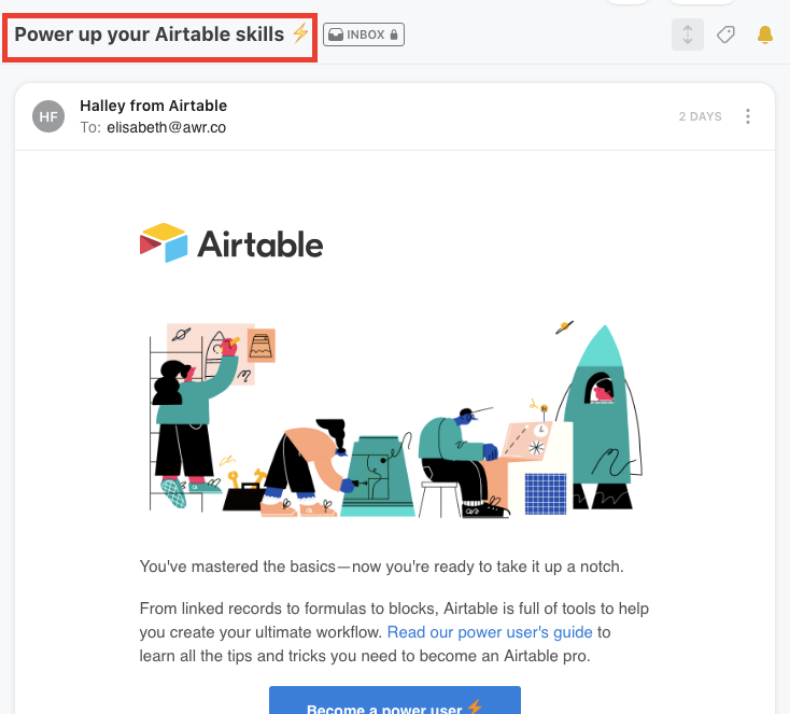
Airtable‘s email subject line
Above all, don’t trick your readers with subject line clickbait. If your subject line says that you’ll be sharing “10 tricks on how to improve employee retention,” ensure that the content meets the expectations that the subject line sets up.
Experiment with the language
Word choice matters. For example, the subject line “Crush your social selling techniques” is more likely to be opened over “How to social sell.” Weave together words in a way that’s both intriguing and direct. And avoid words like “free” in your subject lines — it has been shown to lower email open rates.
Create a sense of urgency
Urgent subject lines have been shown to increase open rates by 22%.Mailchimp also found that including words like “urgent” and “important” result in higher open rates. For example, “Last chance to sign up” suggests that the reader will miss out if they don’t click on your message.
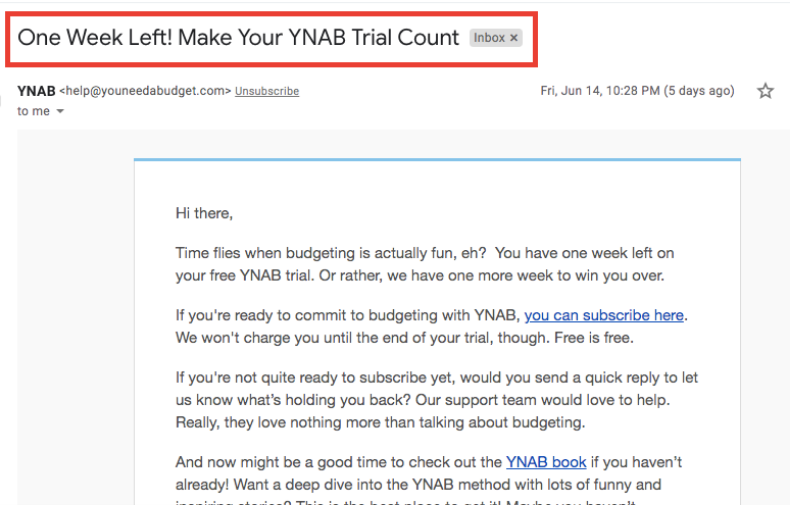
YNAB’s email subject line
Like YNAB, imply time sensitivity to your messages to increase the open rate.
Thank the recipient
Everyone appreciates being appreciated, so it’s not surprising that saying thank you increases email open rates (e.g., “I wanted to say thank you…” or “Thank you for —”). By showing gratitude, you forge a closer bond with the recipient.
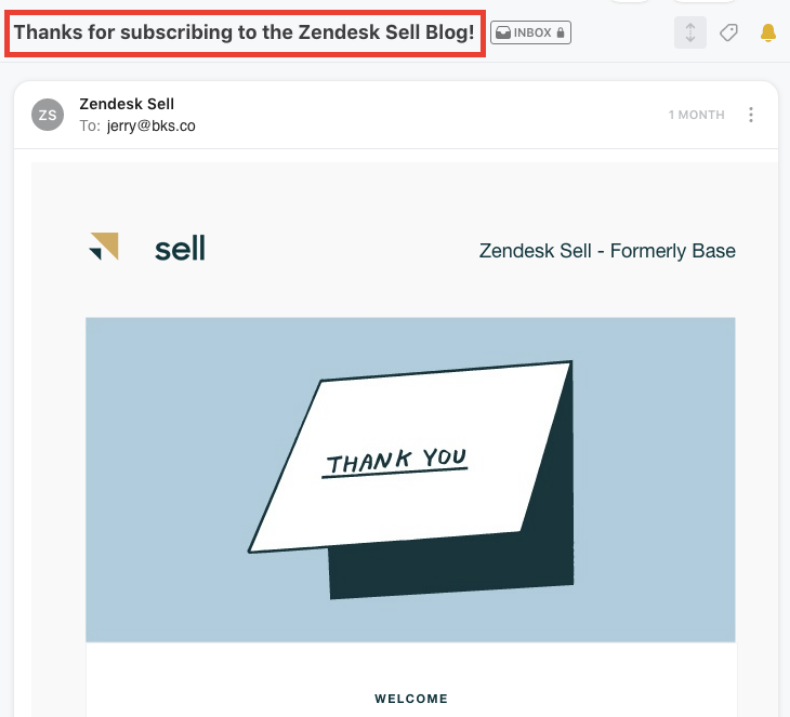
Zendesk Sell’s email subject line
Combine with the contact’s name to make the subject line even more personal: “[Contact Name], thank you!”
Give alliterations a try
If used correctly, alliterations (the repetition of consonant sounds, e.g., The Subscription of the Season) can help make your subject line memorable. Even just a couple of words that work well together can eliminate the monotony of an email. “Want to master memorable marketing?” or “Get your startup financially fit” are a couple of examples.
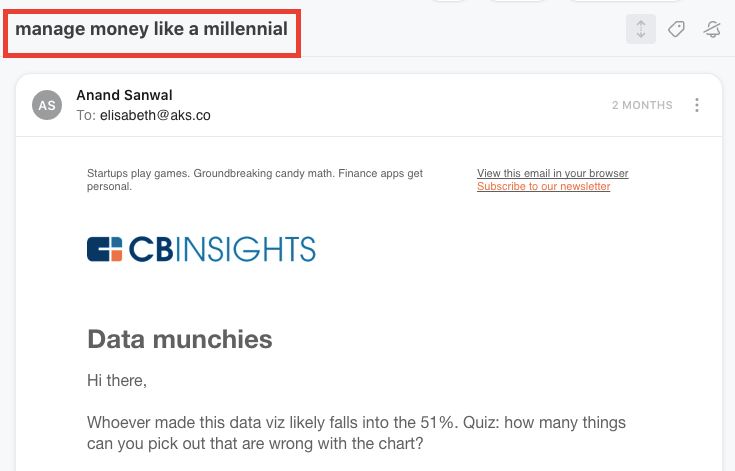
CB Insights‘ email subject line
Granted, you have to be careful with this tactic (it’s easy to overdo). Experiment with different word pairings and find what sounds best for your brand.
Improve your sales email subject lines
Chadwick Martin Bailey found that the subject line is what drives people to open an email 64% of the time. When crafting your subject lines, place yourself in the reader’s shoes. What message would make you want to open the email?
Use a CRM to compile and automatically send your sales emails. Also, experiment with A/B testing with your sales email subject lines. Do some subject lines get a higher click rate than others? If certain subject lines aren’t working, refer to this article again and try something new the next time.
No matter your target audience, be customer-focused with every sales email starting with the subject line.
Digital & Social Articles on Business 2 Community
(33)
Report Post